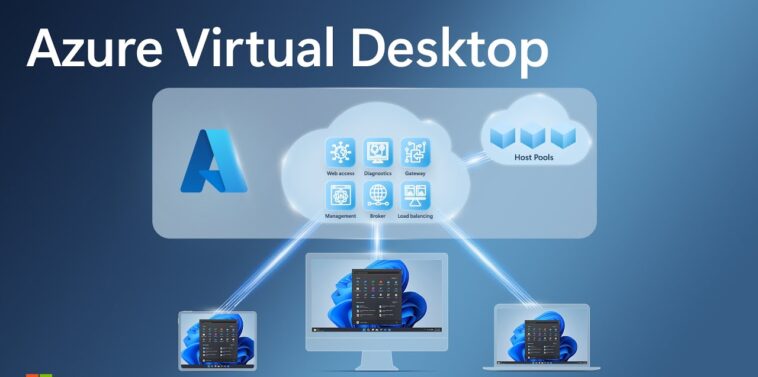VDI Azure
Unlocking Efficiency and Flexibility with Azure Virtual Desktop Infrastructure (VDI)
In the dynamic landscape of cloud computing, businesses are continuously seeking innovative solutions to enhance productivity, security, and flexibility. One such solution that has gained significant traction is Azure Virtual Desktop Infrastructure (VDI). This technology represents a paradigm shift in how organizations manage and deliver desktop environments, providing a virtualized, cloud-based approach that brings numerous benefits to the table.
Understanding VDI Azure:
Azure Virtual Desktop, formerly known as Windows Virtual Desktop, is a comprehensive desktop and app virtualization service provided by Microsoft Azure. Unlike traditional computing models where each user is assigned a physical machine, VDI allows users to access a virtual desktop hosted on a centralized server in the cloud. VDI Azure extends this concept by leveraging the power of Microsoft Azure’s infrastructure to deliver a scalable and efficient virtualization solution.
VDI Azure
Key Features and Benefits:
1. Flexibility and Scalability: Azure VDI offers unparalleled flexibility, enabling organizations to scale their desktop infrastructure based on their evolving needs. Whether you need to accommodate a growing workforce or scale down during less busy periods, Azure VDI provides the agility to adjust resources accordingly. This scalability is particularly valuable in today’s dynamic business environment.
2. Cost-Efficiency: The pay-as-you-go model of VDI Azure ensures that organizations only pay for the resources they consume. Traditional desktop infrastructures often involve substantial upfront costs for hardware and ongoing maintenance. With Azure VDI, these capital expenditures are replaced by a more predictable operational expenditure model, allowing organizations to optimize their budgets more effectively.
3. Enhanced Security: Security is a top priority for businesses, and Azure VDI offers advanced security features. By centralizing desktops and applications in the Azure cloud, organizations can benefit from Microsoft’s robust security infrastructure. Azure VDI supports features such as multi-factor authentication, conditional access policies, and integration with Azure Active Directory, providing a secure environment for end-users.
4. Remote Work Enablement: The rise of remote work has accelerated the need for solutions that enable employees to work from anywhere securely. Azure VDI facilitates remote work by providing a consistent and secure desktop experience regardless of the user’s location. This is especially critical in today’s globalized and decentralized work environments.
5. Simplified Management: Managing traditional desktop environments can be complex and resource-intensive. VDI Azure simplifies this process by centralizing management tasks. Administrators can efficiently handle tasks such as provisioning, updating, and patching virtual desktops from a centralized console, streamlining operations and reducing the overall administrative burden.
Implementation Process:
Implementing VDI Azure involves several key steps:
1. Assessment and Planning: Before migrating to Azure VDI, organizations should conduct a thorough assessment of their current desktop environment. This includes evaluating the number of users, applications, and the overall performance requirements. Proper planning ensures a smooth transition to the virtualized environment.
2. Infrastructure Setup: Setting up the Azure infrastructure involves creating virtual machines, configuring storage, and establishing the necessary network connectivity. VDI Azure integrates seamlessly with other Azure services, allowing organizations to leverage the full capabilities of the cloud.
3. Image Creation and Configuration: Creating a master image for virtual desktops is a crucial step. This image includes the operating system, applications, and configurations needed for end-users. Azure VDI supports image customization and allows organizations to maintain multiple images to cater to diverse user requirements.
4. Deployment and Testing: Once the infrastructure and images are set up, organizations can deploy virtual desktops to end-users. It’s essential to conduct thorough testing to ensure that the virtualized environment meets performance expectations and supports all necessary applications.
5. Management and Optimization: Ongoing management involves monitoring user activity, updating images, and optimizing resource allocation. VDI Azure provides tools and insights to help administrators track performance, troubleshoot issues, and make data-driven decisions.
Challenges and Considerations:
While Azure VDI offers numerous benefits, organizations must be aware of potential challenges. Bandwidth requirements for remote users, licensing costs, and the complexity of transitioning from traditional desktop environments are factors that require careful consideration. Additionally, organizations need to ensure compatibility with existing applications and address any potential resistance from end-users during the migration process.
VDI Azure
Conclusion:
Azure Virtual Desktop Infrastructure is a transformative solution that empowers organizations to embrace the future of computing. By leveraging the capabilities of Microsoft Azure, businesses can enhance flexibility, reduce costs, and strengthen security. The shift towards virtualized desktop environments aligns with the evolving needs of a modern workforce, especially as remote work becomes a prevalent and permanent feature of the business landscape. As organizations embark on their digital transformation journey, Azure VDI stands out as a key enabler, unlocking efficiency and providing a robust foundation for the workplace of tomorrow.




Comments
0 comments